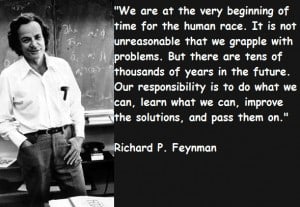
John Neer writes to announce that he has made available “to the public for non-commercial use” an extensive collection of notes for lectures that Richard Feynman delivered to employees of Hughes Aircraft Company from 1966 through 1971, for two hours on Monday evenings, 9 to 10 months per year. No attempt was made to record or capture Feynman’s board work for these lectures. Mr. Neer, accomplishing what would seem to have been a Herculean task, took notes as extensively as possible during Feynman’s two-hour lectures, and then spent four to six hours transcribing each lecture as soon as possible afterward. References and subsequent results from the Internet were added some time later. The lecture notes are available at http://www.thehugheslectures.info/.
These notes are for all those who want to learn more about science, math and nature as Feynman did; to learn more of how he taught and embrace his charge to pass on what we have learned.
I believe consistent with Feynman’s interest to teach as many as he could about science these notes are free and open to the public for non-commercial use.
As to Mr. Neer’s motivations for making available more than 1000 pages (about 132 MB) of notes from more than 400 hours of Feynman’s lectures on topics from cosmology to molecular biology, he writes:
… Over the years I have noted people commenting on how much they would have given to have experienced Feynman in the environment I did. I was truly fortunate to be in his pedagogical presence for so many memorable hours (over 400+ I estimate) and able to soak up some of his genius. The notes are a reflection of my attempt to do just that. I trust the reader will find in the notes the Feynman spirit, intensity and passion he had in both teaching and learning about science and the world we live in. Even his microbiology lecture represents the broader interest and dimension in his personal quest to understand nature and science.
So to those who find these notes both relevant and interesting to augmenting their studies and or their actual work (which includes teaching these subjects) there is an effort required by you to follow the text and even more so the mathematical representation of a given subject or lecture. On those mathematical equations, as Feynman developed them on the blackboard, I worked to write them down as accurately as possible before he erased them to start over on the left side of the boards. It is, therefore, up to the reader/student/teacher then to follow the material and actually check the math as I captured and wrote it down. Errors are certainly there from my rapid capture and reconstruction; perhaps one can find where Feynman actually made a mistake along the way. My syntax and spelling is not perfect I know but the notes should preserves the topic’s integrity and thoroughness. I am sure one can read through those uncorrected textual errors and still be able to understand the content of the lectures. The learning experience is then to follow the material, understand it, find the errors and be smart enough to know how to correct them. Reading the notes for “pleasure” only is not learning; it is like reading a novel. So to all who have downloaded these notes: Enjoy and learn the Feynman way; I am sure he would be pleased to see these notes open and free to the public. …
— John T. Neer, http://www.thehugheslectures.info/about/.
All those interested in Richard Feynman and his many contributions to science, technology, and teaching will appreciate the immense effort made by John T. Neer to bring these notes to the public.
—James Lewis, PhD

